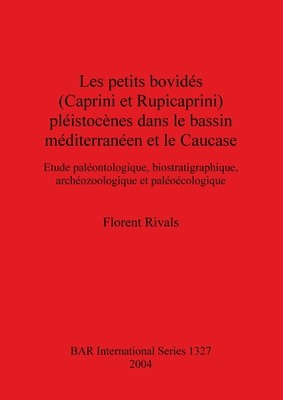
- Išsiųsime per 10–14 d.d.
- Autorius: Florent Rivals
- Leidėjas: British Archaeological Reports Oxford Ltd
- ISBN-10: 1841716723
- ISBN-13: 9781841716725
- Formatas: 21 x 29.7 x 1.9 cm, minkšti viršeliai
- Kalba: Anglų, Prancūzų
- Extra -15 % nuolaida šiai knygai su kodu: ENG15
Les petits bovidés (Caprini et Rupicaprini) pléistocènes dans le bassin méditerranéen et le Caucase + nemokamas atvežimas! | knygos.lt
Atsiliepimai
Aprašymas
This research explores 4 main genera of bovids found in major Middle and Upper Pleistocene sites in the wider Mediterranean area and the Caucasus. Four geographical zones offer sites from Spain to Azerbaijan and include sites at Caune de l'Arago, Portel-Ouest, Arbreda, Hortus, Orgnac 3, Karaïn, Sakazia, and Asych. From a comprehensive study of the faunal evidence, the work provides an outline of early man's relationship to the environment across a wide area. Typically, a zooarchaeological approach was applied to the sites and levels of units I and III of the Caune de l'Arago. Levels M, N and O from unit I correspond to carnivore occupations while in most of the levels of unit III, argali accumulation is due to human occupation. In level F dated from about 440,000 years, the cavity was occupied from the end of spring to the beginning of summer by groups which practised non selective hunting and argali was the main prey. The study of locomotive and dietary adaptations shows that fossil populations had verycomparable adaptations to those of current populations. Dental microwear shows the seasonal changes in food selection which varied with the hunting season of small bovids and with palaeoenvironmental conditions.EXTRA 15 % nuolaida su kodu: ENG15
Akcija baigiasi už 1d.16:43:44
Nuolaidos kodas galioja perkant nuo 10 €. Nuolaidos nesumuojamos.

- Autorius: Florent Rivals
- Leidėjas: British Archaeological Reports Oxford Ltd
- ISBN-10: 1841716723
- ISBN-13: 9781841716725
- Formatas: 21 x 29.7 x 1.9 cm, minkšti viršeliai
- Kalba: Anglų, Prancūzų




Atsiliepimai